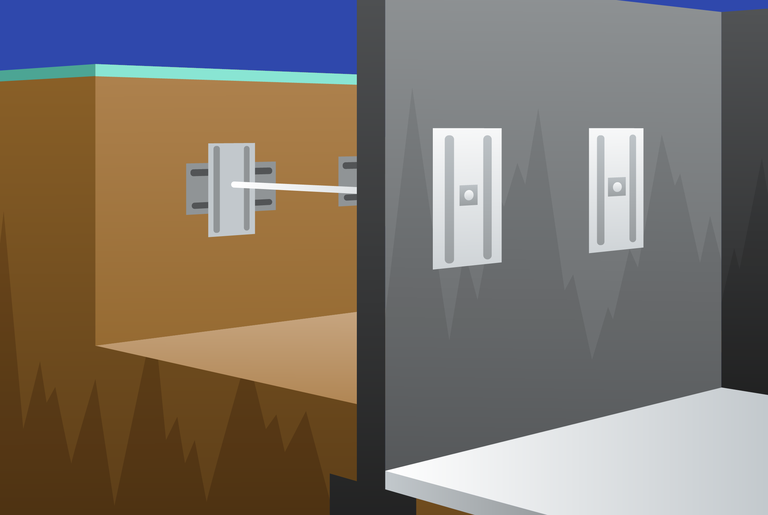Do Wall Plate Anchors Work?
Wall Plate Anchors are steel plates that are installed to stop the inward movement of a Foundation Wall. While there are several techniques to stop and correct this, Wall Plate Anchors tend to work the best and are the most efficient. We will discuss the various aspects of working with them below.
Common Setbacks With Wall Plate Anchors
The idea is simple: Anchor a plate in the yard far enough away so that an anchored plate in the foundation wall will stop the wall from moving. While the idea is simple, there are some things to keep in mind when considering this work:
- These are not recommended in cities where there is no yard space to use. If your neighbor is two feet away, we cannot anchor into their house.
- Trees are common obstacles. Even if trees in the area have been removed, the root system and stumps can cause issues during installation.
- Under 2” of movement can be repaired using Carbon Fiber Straps, which are less invasive. Consider the scope of your work.
- Heavily cracked foundation walls will still need Carbon Fiber installed to keep the wall together while it moves back into place.
- Electrical boxes, gas meters, water lines, and sewer lines must be checked on any wall that is moving. You do not want to move these in unexpected ways, as the results would be costly.
- Access inside the basement. Generally, we need 10 feet from the wall for a proper working area to complete the work. All finished walls on that foundation wall being moved will need to be removed.
- Noise. There will be noise, not only when prepping for the work but also when the foundation wall is moved. Concrete cracks and pops as it moves and rubs against itself. On top of that, the sill plate and wood frame of the home create noise as well. This is common but something that will surprise you if you are not prepared.

How Does Foundation Wall Plate Installation Work?
Foundation wall plate installation is fairly simple. A threaded rod is run through the foundation wall to connect to a plate buried in the yard. Another plate is installed on the inside of the foundation wall. Bolts are threaded on and tightened on either end to bring tension and bracing to the wall. It’s a simple concept, but let’s break the foundation wall plate installation down below step by step for clarity.
- A trench is dug outside the home, roughly 13 feet from the Foundation Wall.
- This trench is used for the anchor plates.
- Holes are drilled through the Foundation Wall and threaded steel rods are pushed through these holes.
- The rods will come out in the trench, and you will know the full length has been reached.
- Plates are installed in the trench on the rod and inside on the Foundation Wall. Bolts are threaded on and tightened.
- Waterproofing membranes are installed as well to prevent water seepage from the holes drilled through the Foundation Wall.
That’s it! It is a simple process to install Wall Plates. However, there is more. What about the situation mentioned above where you are past 2” in wall bowing/tilting? Isn’t that dangerous? It is, and if the movement is beyond half the width of the Foundation Wall, it is considered a structural failure. At this point, we have a few extra steps to do to repair that wall:
- A second trench must be dug next to the foundation. This trench must be dug before the first one for stability of the equipment on the ground. Its purpose is to free up the dirt next to the Foundation Wall, so the wall can freely move.
- The home’s weight above the foundation must be lifted to allow the wall to move. This is accomplished using hydraulic jacks and support beams.
- Bracing is sometimes required at the top of the wall to prevent the wall above the Foundation Wall from moving.
- Carbon Fiber may also be necessary to install. If the Foundation Wall is cracked badly, the plates may cause one section of the wall to move but not a broken separated section. Carbon Fiber Straps will bring the wall back together and allow it all to move as one unit.
Foundation Crack Repair
Once all the steps above have been completed, the only thing left to do is repair the Foundation Cracks. What Foundation Cracks, you say? Well, the cracks are going to be there, as a massive piece of concrete has been shifting, bowing, and tilting. These cracks need to be injected via Epoxy Injection to prevent water from penetrating through into the basement.
Wall plate anchors at The Real Seal Basement Waterproofing & Foundation Repair come with a 25-Year Warranty. We also offer Chicago crawl space encapsulation services.
REQUEST A FREE ESTIMATE

DOWNLOAD OUR FREE GUIDE
We created a guide titled:
“A Homeowner’s Guide to Basement Waterproofing” to help you spot common basement issues around your home and learn how to fix them. Enter your email and get the free guide.
“Not Everything’s Better When Wet”®
